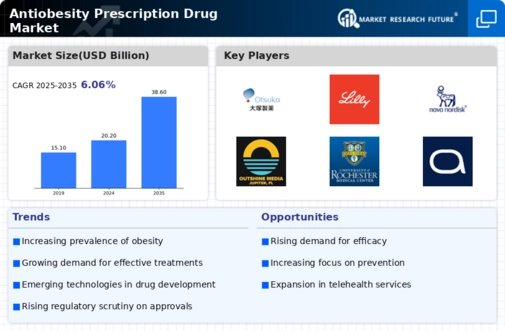The Antiobesity Prescription Drug Market is currently characterized by a dynamic competitive landscape, driven by increasing obesity rates globally and a growing emphasis on effective weight management solutions. Key players such as Novo Nordisk (Denmark), Eli Lilly (United States), and Pfizer (United States) are at the forefront, each adopting distinct strategies to enhance their market presence. Novo Nordisk (Denmark) focuses on innovation, particularly with its GLP-1 receptor agonists, which have shown promising results in weight loss. Eli Lilly (United States) is also heavily invested in research and development, particularly with its new drug, tirzepatide, which has garnered attention for its efficacy. Pfizer (United States), while traditionally known for its diverse pharmaceutical portfolio, is increasingly pivoting towards obesity treatments, indicating a strategic shift in its operational focus. Collectively, these strategies contribute to a competitive environment that is both collaborative and competitive, as companies seek to leverage their strengths in innovation and market reach.
In terms of business tactics, companies are increasingly localizing manufacturing and optimizing supply chains to enhance efficiency and reduce costs. The market structure appears moderately fragmented, with several players vying for dominance while also collaborating on research initiatives. This fragmentation allows for a variety of treatment options, catering to diverse patient needs, while the influence of key players remains substantial in shaping market trends and consumer preferences.
In August 2025, Eli Lilly (United States) announced a strategic partnership with a leading telehealth provider to enhance patient access to its obesity treatments. This move is significant as it not only broadens the reach of Eli Lilly's products but also aligns with the growing trend of digital health solutions, potentially improving patient adherence and outcomes. The integration of telehealth services could serve as a model for other companies in the sector, emphasizing the importance of accessibility in treatment.
In September 2025, Novo Nordisk (Denmark) launched a new patient support program aimed at improving treatment adherence for its obesity drug, semaglutide. This initiative underscores the company's commitment to patient-centric care and highlights the importance of support systems in managing chronic conditions like obesity. By focusing on patient engagement, Novo Nordisk is likely to enhance its competitive edge in a market that increasingly values holistic treatment approaches.
In October 2025, Pfizer (United States) revealed plans to expand its clinical trials for a new obesity drug targeting specific genetic markers associated with weight gain. This strategic decision reflects a growing trend towards personalized medicine in the obesity treatment landscape. By tailoring treatments to individual genetic profiles, Pfizer may position itself as a leader in innovative therapeutic approaches, potentially reshaping the competitive dynamics of the market.
As of October 2025, current trends in the Antiobesity Prescription Drug Market are increasingly defined by digitalization, sustainability, and the integration of artificial intelligence in drug development. Strategic alliances are becoming more prevalent, as companies recognize the value of collaboration in navigating complex regulatory environments and enhancing research capabilities. Looking ahead, competitive differentiation is likely to evolve from traditional price-based competition towards a focus on innovation, technological advancements, and supply chain reliability. This shift may redefine how companies position themselves in the market, emphasizing the need for agility and responsiveness to changing consumer demands.

















Leave a Comment